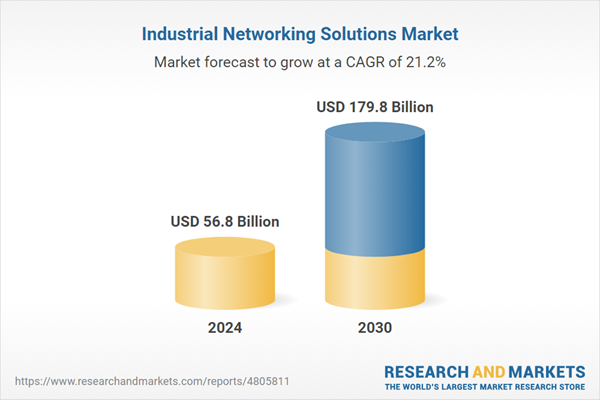The global market for Industrial Networking Solutions was valued at US$56.8 Billion in 2024 and is projected to reach US$179.8 Billion by 2030, growing at a CAGR of 21.2% from 2024 to 2030. This comprehensive report provides an in-depth analysis of market trends, drivers, and forecasts, helping you make informed business decisions. The report includes the most recent global tariff developments and how they impact the Industrial Networking Solutions market.
Segments: Technology (IIoT, SDWAN, WLAN); Application (Emergency & Incident Management, Remote Monitoring, Asset Tracking & Management, Supply Chain Management, Real-Time Streaming & Video, Predictive Maintenance).
Geographic Regions/Countries: World; United States; Canada; Japan; China; Europe (France; Germany; Italy; United Kingdom; and Rest of Europe); Asia-Pacific; Rest of World.
The analysts continuously track trade developments worldwide, drawing insights from leading global economists and over 200 industry and policy institutions, including think tanks, trade organizations, and national economic advisory bodies. This intelligence is integrated into forecasting models to provide timely, data-driven analysis of emerging risks and opportunities.
Global Industrial Networking Solutions Market - Key Trends & Drivers Summarized
Why Are Industrial Networking Solutions Essential in the Age of Smart Manufacturing?
Industrial networking solutions have become a fundamental component of modern industrial operations, enabling seamless communication between machines, systems, and enterprise networks. As industries embrace automation, robotics, and real-time data analytics, the demand for robust and secure industrial networking infrastructures has surged. These solutions include industrial Ethernet, wireless networking, edge computing, and fieldbus technologies that facilitate efficient data exchange, process optimization, and remote monitoring. The rise of Industry 4.0 and the Industrial Internet of Things (IIoT) has further accelerated the adoption of advanced networking solutions, allowing manufacturers to integrate smart devices, sensors, and controllers across production floors. Unlike traditional IT networks, industrial networking solutions are designed to withstand harsh environments, offering enhanced durability, low latency, and high reliability for mission-critical applications. In manufacturing plants, smart grids, oil refineries, and logistics hubs, real-time data transfer and process automation rely heavily on high-speed industrial networks that support scalable and interoperable connectivity. Moreover, cybersecurity has become a significant concern, leading to the implementation of secure networking protocols, network segmentation strategies, and AI-driven threat detection mechanisms. As industrial environments become increasingly connected, networking solutions are playing a crucial role in ensuring operational continuity, predictive maintenance, and enhanced decision-making capabilities.How Are Technological Advancements Transforming Industrial Networking Infrastructure?
The industrial networking landscape is undergoing rapid transformation due to technological advancements in wireless communication, edge computing, and cloud-integrated systems. The deployment of 5G technology is revolutionizing industrial networks, offering ultra-low latency and high-speed data transfer capabilities critical for applications such as autonomous manufacturing, remote equipment monitoring, and AI-driven process automation. The integration of artificial intelligence (AI) and machine learning (ML) in network management has also enabled predictive analytics, self-healing networks, and intelligent load balancing, ensuring minimal downtime and improved efficiency. Additionally, the adoption of Time-Sensitive Networking (TSN) protocols is enhancing real-time communication in industrial environments, allowing precise synchronization of automation equipment, robotic arms, and connected sensors. Edge computing is another game-changing innovation, enabling decentralized data processing closer to the source, reducing network congestion, and improving response times for time-sensitive applications. With the rise of hybrid industrial-cloud models, companies are increasingly leveraging cloud-based networking solutions to manage distributed industrial assets while maintaining centralized control. The introduction of next-generation wireless technologies, including Wi-Fi 6, LoRaWAN, and private LTE networks, has further expanded connectivity options for industrial environments, offering flexibility in designing scalable and secure networks. As industries push toward greater digitalization, the convergence of IT and operational technology (OT) networks is becoming a strategic priority, leading to the development of software-defined networking (SDN) and intent-based networking (IBN) solutions that simplify network management and automation.Why Is the Demand for Industrial Networking Solutions Increasing Across Key Sectors?
The adoption of industrial networking solutions is witnessing a sharp rise across multiple industries, driven by the need for enhanced operational efficiency, real-time monitoring, and seamless integration of smart technologies. The manufacturing sector is one of the largest consumers of industrial networking solutions, leveraging Ethernet-based and wireless networking infrastructures to optimize automated production lines, robotic workstations, and supply chain logistics. In the energy sector, smart grids and renewable energy installations require high-speed, resilient networking solutions to monitor power distribution, integrate distributed energy resources, and manage grid stability. The oil and gas industry relies on industrial networking to support remote asset monitoring, predictive maintenance, and real-time data analytics in offshore and onshore facilities. Meanwhile, the logistics and transportation industry has increasingly adopted networked systems for fleet management, autonomous vehicles, and warehouse automation, ensuring smooth supply chain operations. The healthcare industry is also experiencing a rise in industrial networking applications, particularly in medical device connectivity, smart hospital infrastructure, and telemedicine services. With the rapid expansion of data centers and edge computing facilities, networking solutions have become vital in supporting high-bandwidth, low-latency communication for mission-critical workloads. Furthermore, the aerospace and defense sectors are integrating industrial networking into avionics systems, remote monitoring of military assets, and secure communication networks, ensuring reliability in high-stakes operations. As urbanization and infrastructure development accelerate, smart cities are increasingly deploying industrial networking solutions for intelligent traffic management, connected surveillance systems, and automated utilities management, further broadening the market scope.What Are the Key Factors Driving the Growth of the Industrial Networking Solutions Market?
The growth in the industrial networking solutions market is driven by several factors, including the rapid adoption of smart manufacturing, advancements in wireless communication, and the increasing need for secure and scalable network infrastructures. The proliferation of IIoT devices and real-time data analytics has led to an exponential increase in network traffic, necessitating the deployment of high-performance industrial Ethernet and wireless connectivity solutions. The rise of 5G technology has further accelerated market expansion, as industries seek ultra-fast, low-latency networks capable of supporting autonomous operations and remote-controlled systems. The growing emphasis on cybersecurity in industrial environments has also played a crucial role, with companies investing in advanced network security solutions, intrusion detection systems, and AI-driven threat prevention mechanisms. The push for energy-efficient and sustainable industrial processes has fueled demand for intelligent networking solutions that enable remote asset monitoring, predictive maintenance, and data-driven decision-making. Additionally, the increasing integration of cloud-based networking solutions is driving market growth, allowing enterprises to centralize network management while maintaining real-time control over distributed industrial assets. The expansion of smart city initiatives, electric vehicle infrastructure, and intelligent transportation systems has further reinforced the importance of industrial networking solutions in enabling interconnected and automated urban environments. With ongoing digital transformation initiatives across industries, the demand for robust, secure, and high-speed networking solutions is expected to surge, shaping the future of industrial connectivity in an increasingly automated and data-driven world.Report Scope
The report analyzes the Industrial Networking Solutions market, presented in terms of units. The analysis covers the key segments and geographic regions outlined below.Segments: Technology (IIoT, SDWAN, WLAN); Application (Emergency & Incident Management, Remote Monitoring, Asset Tracking & Management, Supply Chain Management, Real-Time Streaming & Video, Predictive Maintenance).
Geographic Regions/Countries: World; United States; Canada; Japan; China; Europe (France; Germany; Italy; United Kingdom; and Rest of Europe); Asia-Pacific; Rest of World.
Key Insights:
- Market Growth: Understand the significant growth trajectory of the IIoT Technology segment, which is expected to reach US$99.9 Billion by 2030 with a CAGR of a 21.5%. The SDWAN Technology segment is also set to grow at 22.3% CAGR over the analysis period.
- Regional Analysis: Gain insights into the U.S. market, valued at $16.0 Billion in 2024, and China, forecasted to grow at an impressive 20.0% CAGR to reach $26.6 Billion by 2030. Discover growth trends in other key regions, including Japan, Canada, Germany, and the Asia-Pacific.
Why You Should Buy This Report:
- Detailed Market Analysis: Access a thorough analysis of the Global Industrial Networking Solutions Market, covering all major geographic regions and market segments.
- Competitive Insights: Get an overview of the competitive landscape, including the market presence of major players across different geographies.
- Future Trends and Drivers: Understand the key trends and drivers shaping the future of the Global Industrial Networking Solutions Market.
- Actionable Insights: Benefit from actionable insights that can help you identify new revenue opportunities and make strategic business decisions.
Key Questions Answered:
- How is the Global Industrial Networking Solutions Market expected to evolve by 2030?
- What are the main drivers and restraints affecting the market?
- Which market segments will grow the most over the forecast period?
- How will market shares for different regions and segments change by 2030?
- Who are the leading players in the market, and what are their prospects?
Report Features:
- Comprehensive Market Data: Independent analysis of annual sales and market forecasts in US$ Million from 2024 to 2030.
- In-Depth Regional Analysis: Detailed insights into key markets, including the U.S., China, Japan, Canada, Europe, Asia-Pacific, Latin America, Middle East, and Africa.
- Company Profiles: Coverage of players such as ABB Group, Aruba Networks, Belden, Inc., Cisco Systems, Inc., Dell EMC and more.
- Complimentary Updates: Receive free report updates for one year to keep you informed of the latest market developments.
Some of the 42 companies featured in this Industrial Networking Solutions market report include:
- ABB Group
- Aruba Networks
- Belden, Inc.
- Cisco Systems, Inc.
- Dell EMC
- Eaton Corporation PLC
- Huawei Technologies Co., Ltd.
- Juniper Networks, Inc.
- Moxa, Inc.
- Rockwell Automation, Inc.
- Sierra Wireless, Inc.
- Veryx Technologies Pvt. Ltd.
Tariff Impact Analysis: Key Insights for 2025
Global tariff negotiations across 180+ countries are reshaping supply chains, costs, and competitiveness. This report reflects the latest developments as of April 2025 and incorporates forward-looking insights into the market outlook.The analysts continuously track trade developments worldwide, drawing insights from leading global economists and over 200 industry and policy institutions, including think tanks, trade organizations, and national economic advisory bodies. This intelligence is integrated into forecasting models to provide timely, data-driven analysis of emerging risks and opportunities.
What’s Included in This Edition:
- Tariff-adjusted market forecasts by region and segment
- Analysis of cost and supply chain implications by sourcing and trade exposure
- Strategic insights into geographic shifts
Buyers receive a free July 2025 update with:
- Finalized tariff impacts and new trade agreement effects
- Updated projections reflecting global sourcing and cost shifts
- Expanded country-specific coverage across the industry
Table of Contents
I. METHODOLOGYII. EXECUTIVE SUMMARY2. FOCUS ON SELECT PLAYERSIII. MARKET ANALYSISIV. COMPETITION
1. MARKET OVERVIEW
3. MARKET TRENDS & DRIVERS
4. GLOBAL MARKET PERSPECTIVE
UNITED STATES
CANADA
JAPAN
CHINA
EUROPE
FRANCE
GERMANY
ITALY
UNITED KINGDOM
REST OF EUROPE
ASIA-PACIFIC
REST OF WORLD
Companies Mentioned (Partial List)
A selection of companies mentioned in this report includes, but is not limited to:
- ABB Group
- Aruba Networks
- Belden, Inc.
- Cisco Systems, Inc.
- Dell EMC
- Eaton Corporation PLC
- Huawei Technologies Co., Ltd.
- Juniper Networks, Inc.
- Moxa, Inc.
- Rockwell Automation, Inc.
- Sierra Wireless, Inc.
- Veryx Technologies Pvt. Ltd.
Table Information
| Report Attribute | Details |
|---|---|
| No. of Pages | 194 |
| Published | April 2025 |
| Forecast Period | 2024 - 2030 |
| Estimated Market Value ( USD | $ 56.8 Billion |
| Forecasted Market Value ( USD | $ 179.8 Billion |
| Compound Annual Growth Rate | 21.2% |
| Regions Covered | Global |









